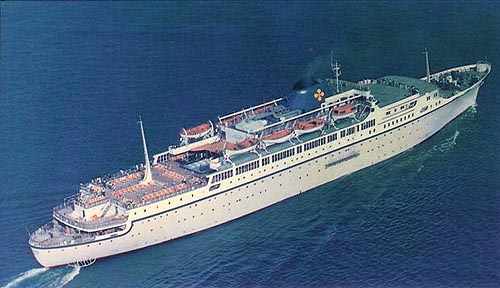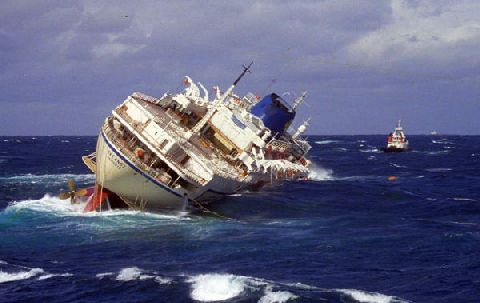|

|
| Oceanos At Sea |
Leaking
Greek Liner Oceanios Sunk On African Coast
By
James Donahue
After
39 years at sea and going through numerous owners and name changes, the Greek liner Oceanios was a disaster waiting to happen
in August, 1991 when it began its final voyage from East London, South Africa, to Durban with 571 passengers and crew.
Shipping
specialists from other nations might well have marked the Oceanos as unseaworthy had it been operating from European or North
American ports of call. After acquisition by the Epirotiki Line and given its final name in 1976, the vessel operated in the
Mediterranean until 1988, when it began service to South African ports, eventually falling into a state of neglect.
When
the liner departed East London on August 3, it was already taking on water from loose hull plates. Also there was a 3.9-inch
hole cut in what should have been a watertight bulkhead between the generator room and a sewage-holding tank. There had been
problems with bulk water rising through showers and toilets and workers had removed ventilation pipes and non-return valves
for repairs that were not completed.
August
is winter south of the equator, and the Oceanios sailed directly into a winter storm packing 40-knot winds and nine meter
swells. The 500-foot ship was rolling so severely that the usual deck party was abandoned as passengers chose to stay in their
cabins.
The storm
intensified that evening to the point where the waiters in the dining room struggled to carry their food trays without dropping
things. They said crockery and cutlery was sliding off the tables and potted plants were falling over.
Sometime
around 9:30 p.m., while off the Wild Coast of the Transkei, the ship’s engineer reported to the bridge that water was
entering the hull and flooding the generator room. There was a leak in the engine room’s sea chest, a device that scooped
up cooling water. Before the rising water shorted the generators, they were shut down and the vessel went dark. Auxiliary
power also was lost so the engines shut down and the Oceanios was left adrift in the dark.

|
| Listing And Doomed |
The water steadily gained, flooding through the hole in the bulkhead and into the waste disposal tank. Because
the valves that closed the holding tank had been removed, the water soon forced its way through the drain pipes and began
spilling out of the showers, toilets and waste disposal units throughout the ship.
Realizing
that the ship was in a sinking state, the crew panicked, packed their personal things and headed for the lifeboats without
sounding an alarm. In their haste, they failed to close lower deck port holes, thus accelerating the sinking of the vessel.
Passengers
later said they were not aware that the ship was sinking until people noticed flooding in the lower decks. By then, they said
they found the entire crew, including Captain Avanaras, packed and prepared to launch the lifeboats.
Avranas
later defended his actions. He said he left the ship first to arrange for a rescue effort. He said he wanted to supervise
the rescue from a helicopter.
Fortunately,
the radio room got off an S.O.S. before the power was cut, and that launched a successful rescue of the people left stranded
on the liner. The South African Navy and Air Force conducted a successful rescue effort, using 16 helicopters to airlift the
passengers and crew to the nearby shore. Everybody was successfully removed before the Oceanos rolled on its side and sank.
The liner
was launched in France as the Jean Laborde in 1952. It was one of a fleet of four sister ships operated by Messageries Maritimes
that offered passenger and freight service from Marseilles to Madagascar and Mauritius.
Before
its sale to the Greek owners, the ship went through several name changes that included Mykinai, Ancona and Eastern Princess.
|

